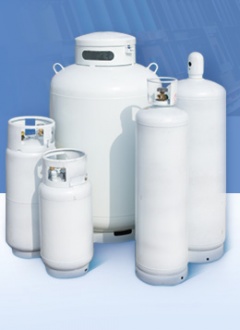Difference between revisions of "Propane Gas"
| Line 8: | Line 8: | ||
}} | }} | ||
==Description== | ==Description== | ||
| − | + | Propane properties: colourless gas, natural gas odour, non-corrosive.<br><br> | |
| − | + | Propane, the most common liquefied petroleum gas (LP-gas), is one of the nation's most versatile sources of energy and supplies about 4% of our total energy needs.<br> | |
| − | + | Propane exists as a liquid and a gas. At atmospheric pressure and temperatures above –44 F, it is a non-toxic, colourless and odourless gas. Just as with natural gas, an identifying odour is added so it can be readily detected. When contained in an approved cylinder or tank, propane exists as a liquid and vapour. The vapour is released from the container as a clean-burning fuel gas. Propane is 270 times more compact as a liquid than as a gas, making it economical to store and transport as a liquid.<br><br> | |
| − | <br><br> | + | Propane is a three-carbon [[alkane]] with the molecular formula C3H8, normally a gas, but compressible to a transportable liquid. A by-product of natural gas processing and petroleum refining, it is commonly used as a fuel for engines, oxy-gas torches, barbecues, portable stoves, and residential central heating. Propane is one of a group of liquefied petroleum gases. The others include butane, propylene, butadiene, butylene, isobutylene and mixtures thereof.<br><br> |
| − | + | Propane containing too much propene (also called propylene) is not suited for most vehicle fuels. HD-5 is a specification which establishes a maximum concentration of 5% propene in propane. Propane and other LP gas specifications are established in ASTM D-1835. All propane fuels include an odorant, almost always ethanethiol, so that people can easily smell the gas in case of a leak. Propane as HD-5 was originally intended for use as vehicle fuel. HD-5 is currently being used in all propane applications.<br><br> | |
| − | <br><br> | + | Propane is produced as a by-product of two other processes, natural gas processing and petroleum refining. The processing of natural gas involves removal of butane, propane, and large amounts of ethane from the raw gas, in order to prevent condensation of these volatiles in natural gas pipelines. Additionally, oil refineries produce some propane as a by-product of cracking petroleum into gasoline or heating oil. The supply of propane cannot easily be adjusted to meet increased demand, because of the by-product nature of propane production.<br><br> |
| − | + | ==Application== | |
| + | |||
| + | |||
| + | |||
| + | [[Category:Products]] | ||
[[Category:Oil and chemicals]] | [[Category:Oil and chemicals]] | ||
| − | |||
Revision as of 09:39, 2 April 2014
| Infobox on Propane Gas | |
|---|---|
| Example of Propane Gas |  |
| Facts | |
| Origin | - |
| Stowage factor (in m3/t) | - |
| Humidity / moisture | - |
| Ventilation | - |
| Risk factors | See text |
Propane Gas
Contents
Description
Propane properties: colourless gas, natural gas odour, non-corrosive.
Propane, the most common liquefied petroleum gas (LP-gas), is one of the nation's most versatile sources of energy and supplies about 4% of our total energy needs.
Propane exists as a liquid and a gas. At atmospheric pressure and temperatures above –44 F, it is a non-toxic, colourless and odourless gas. Just as with natural gas, an identifying odour is added so it can be readily detected. When contained in an approved cylinder or tank, propane exists as a liquid and vapour. The vapour is released from the container as a clean-burning fuel gas. Propane is 270 times more compact as a liquid than as a gas, making it economical to store and transport as a liquid.
Propane is a three-carbon alkane with the molecular formula C3H8, normally a gas, but compressible to a transportable liquid. A by-product of natural gas processing and petroleum refining, it is commonly used as a fuel for engines, oxy-gas torches, barbecues, portable stoves, and residential central heating. Propane is one of a group of liquefied petroleum gases. The others include butane, propylene, butadiene, butylene, isobutylene and mixtures thereof.
Propane containing too much propene (also called propylene) is not suited for most vehicle fuels. HD-5 is a specification which establishes a maximum concentration of 5% propene in propane. Propane and other LP gas specifications are established in ASTM D-1835. All propane fuels include an odorant, almost always ethanethiol, so that people can easily smell the gas in case of a leak. Propane as HD-5 was originally intended for use as vehicle fuel. HD-5 is currently being used in all propane applications.
Propane is produced as a by-product of two other processes, natural gas processing and petroleum refining. The processing of natural gas involves removal of butane, propane, and large amounts of ethane from the raw gas, in order to prevent condensation of these volatiles in natural gas pipelines. Additionally, oil refineries produce some propane as a by-product of cracking petroleum into gasoline or heating oil. The supply of propane cannot easily be adjusted to meet increased demand, because of the by-product nature of propane production.











